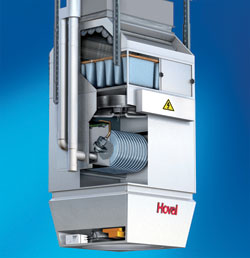When considering design options for the heating and ventilation of large industrial spaces, there are a number of requirements that need to be addressed to provide the best solution. Chris Ree of Hoval discusses which options may be most appropriate for a variety of scenarios
HEATING systems in factories, warehouses and other shed type buildings need to take account of a number of interacting factors. Consequently, system designers need to be aware of all of these factors before they can choose the most appropriate solution.
Fuel costs are, of course, a major factor, so it is important to select an efficient design solution that will minimise fuel usage while providing high performance and maintaining a competitive installation cost.
For example, if there are industrial processes with high temperature extract air or fluid discharge, it may be possible to recover heat for some or all of the space heating. But, as extract air systems create a negative pressure, it is important to balance extract volumes with make-up air to avoid uncontrolled infiltration through the building fabric.
It is equally important to ensure design temperatures are suitable for the activity within each space, so that zones where workers are sedentary will have higher temperatures than those where a higher level of physical activity is prevalent. Also, manufacturing processes may require controlled temperature conditions, so special enclosed zones will help to provide cost-effective operation in a controlled environment.
Fume dissipation from manufacturing processes is normally dealt with at a local level with individual extract to discharge the fumes to atmosphere, using local make-up air supply to balance exhaust volumes. Here, it is important to maintain minimum temperature gradients to keep heat losses and fuel usage to a minimum.
Seasonal adjustment
In the UK, heating systems often operate at partial load for most of the heating season (typically 30% load for 81% of the heating system). So the ability to modulate the heating to 30% or less will help to reduce fuel consumption.
At the same time, it is essential to ensure that ventilation requirements comply with CIBSE recommendations, and airflow distribution patterns will range from one area to another. In high bay racking where a narrow angle of distribution is required, a nozzle system with airflow diffusion angles as low as 26˚ has a high induction effect and will ensure efficient distribution.
In contrast, open zone areas will benefit from a wide diffused airflow pattern, ideally combined with an automated adjustable diffuser to maintain comfort in all flow temperature conditions.
Considering all of these factors helps to inform the decision making process and guide it in the direction of the optimum design. For instance, radiant heating systems provide comfort for occupants within the effective reflected radiant area where there are relatively low ambient air temperatures.
But, as radiant tubes need to maintain a high surface temperature, it is not effective to modulate the burner, so some units may have to be switched off under partial-load conditions.
In addition, convected heat from radiant systems will collect at high level and may be lost through the roof unless destratification mechanisms are deployed.
To overcome these limitations, it is common to combine radiant heating in loading bays where doors are regularly open with warm-air heating in main working areas. In this scenario, the warm-air heating meets all of the requirements for fast response, modulation and ventilation.
Occupied mezzanine areas often suffer from elevated temperatures because of solar heat gains and temperature gradients. Here, it is worth considering the use of free cooling and indirect adiabatic cooling (which will not affect relative humidity) as a low-cost, energy-efficient option, before choosing mechanical cooling.

Hovels Top Vent is designed for high-ceiling spaces
Renewable energy
It is now essential to incorporate the flexibility to use renewable energy (solar, heat pumps, biomass etc) in any heating design, bearing in mind that in many cases the renewable element will only meet a proportion of the total heat requirement. These design considerations are best resolved with a decentralised type systems that incorporates a number of key features.
These features include heat recovery, ventilation and make-up air, airflow distribution control, efficient air filtration, supply and extract air options (including ducted), fan speed control and the facility to use free cooling and indirect adiabatic cooling. Decentralised systems should also be able to incorporate different heating or cooling sources, and have the ability to use special system distribution such as fabric socks, displacement units or nozzle distribution.
Crucially, the system should also be adaptable to future changes in building use or new renewable energy sources.
Because of the complexity of such projects, there are clear benefits to teaming up with a supplier that has experience of all of these requirements, including condensing and biomass boilers, solar collectors, heat pumps, process heat recovery units, indirect adiabatic cooling units and cross flow heat.